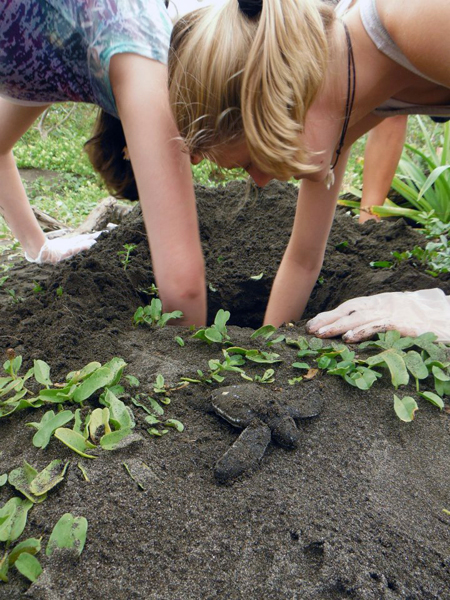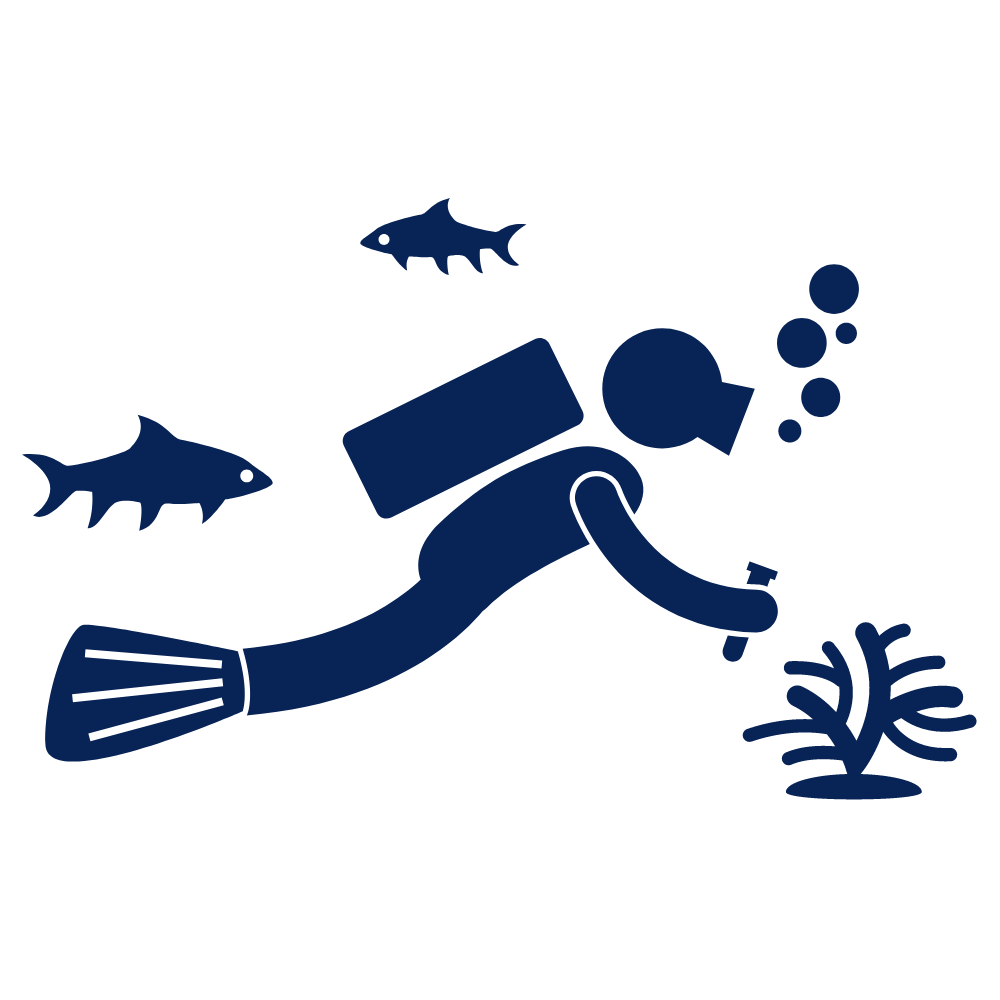Posted by Rick Civelli | 07.16.2012 | Sea Turtle Camp News
Travels in the land of the Tico part III
Buenas Noches Sea Turtle Camp Family and Friends,
Ok, I know most are just waiting to hear about our turtle patrols and the experiences we have had thus far with the sea turtles. As many of you know, our Earth is changing, climates and weather patterns are changing and this trip has shown us a direct effect this is having on the nesting turtles of the Caribbean.
The good news is we had the chance to help with an exhumation, or excavation of a hatched nest to check for live baby turtles that did not make it out with the rest of the clutch, count the number of hatched, unhatched, and non-viable eggs, and record the information for the database. During our exhumation we found 8 baby leatherbacks that without help would have more than likely not made it. Most research suggests that only 1 in 1,000 eggs make it past the first year and only 1 in 10,000 reach reproductive maturity. With efforts like this happening around the world we are helping to give the sea turtles a better chance.
help with an exhumation, or excavation of a hatched nest to check for live baby turtles that did not make it out with the rest of the clutch, count the number of hatched, unhatched, and non-viable eggs, and record the information for the database. During our exhumation we found 8 baby leatherbacks that without help would have more than likely not made it. Most research suggests that only 1 in 1,000 eggs make it past the first year and only 1 in 10,000 reach reproductive maturity. With efforts like this happening around the world we are helping to give the sea turtles a better chance.
If you have had the opportunity to see hatchling sea turtles it is one that is surreal and a truly awesome (and, yes, I use awesome in literal meaning) experience! When the turtles leave the nest they are slow and groggy. Movement is deliberate, but uncoordinated. After a few minutes, they find their bearings and begin their journey to the ocean. In a perfect setting, the clutch of baby sea turtles would hatch over a couple of days, then emerge together under the protection of the night sky and they would follow the brightest light in the sky, which would be the waves in the ocean.
During our exhumation we carefully dug into the nest cavity and extracted the remaining turtles. Since most were still in a sluggish state and needed time to acclimate to their new surroundings we dug small pits for the turtles to become acquainted to the outside environment. Once we had all the leatherback hatchlings we moved them from their small pits unto the open sand for their journey to the sea. The black sand beaches of the region can be a very hostile place for a tiny turtle. The waves roll up the steep coast with enough force to knock a child off their feet, then the water moves back into the ocean pulling almost anything in its path. The turtles we helped made it to the surf zone, washed with the waves, leading them to a new journey towards the Sargasso Sea where they will find refuge and grow. Given the right conditions and about 35-50 years, hopefully one of the females will make its way back to the beaches of Costa Rica to nest.
On our last night here in Parismina, we all gathered as usual at the sea turtle patrol hut, waiting for our volunteer guides to start our 8 pm to 12 am shift. So far we had not seen a nesting sea turtle in any of our night patrols. We had seen plenty of hatchlings, so we were really hoping to see one of the adults on our last night. We walked on the beach and found it extremely dark. We had grown accustomed to having the moon out on our 12am to 4am shifts. We followed our guides down the beach as we had done in the past five nights. Even being in almost complete darkness, we could still see trunks, stumps, and shadows of disturbed sand.
to 12 am shift. So far we had not seen a nesting sea turtle in any of our night patrols. We had seen plenty of hatchlings, so we were really hoping to see one of the adults on our last night. We walked on the beach and found it extremely dark. We had grown accustomed to having the moon out on our 12am to 4am shifts. We followed our guides down the beach as we had done in the past five nights. Even being in almost complete darkness, we could still see trunks, stumps, and shadows of disturbed sand.
A few yards from our first rest stop some of us noticed a wide, darker pattern on the sand, as if a bulldozer had plowed through it leaving a track. We wondered if it could possibly be a sea turtle. The tracks looked wider and deeper than the tracks from green sea turtles and hawksbill that we had seen in previous nights from turtles that had come up the beach to explore but had decided not to nest. A few seconds later our guides stopped and told us “Tortuga, Tortuga!” We all stopped, excited to hear that there was a turtle somewhere in front of us, and hoping that we did not scare it. We waited for the volunteers to check if it was alright for us to move closer.
Sea turtles are usually skittish while they are on the beach, unless they are already laying their eggs. When a turtle is laying a nest, it enters a trance and it does not get spooked, so the volunteers can approach it, measure it, and tag it. The turtle in front of us was a leatherback (baula, in Spanish), and she was in a daze, already laying the nest. She was enormous, measuring 159 cm in length (not including the head) and 112 cm at its widest point – that would be approximately a yard and a half in length and a little over a yard in width. For a leatherback this is not extremely large, but in this region, the leatherback was one of the biggest the locals had ever seen.
The turtle was almost done nesting: it was already covering its eggs. We were all able to see it, and one of us helped measure the turtle. Its carapace felt like a thin, smooth skin, with a little cushioning underneath, like if you were pressing on the back of your hand. This leatherback was magnificent, almost pre-historic looking. For most of us, this was the first nesting sea turtle we have ever seen. And for all of us, this was our first adult leatherback! It was a very memorable, amazing experience. We were all in awe, feeling extremely lucky to be able to see the largest of the sea turtles, on our very last night in Parismina. This may also have been the last leatherback nesting here this year because this is a little past the end of their nesting season. We watched her head back to the ocean, and then disappear into the waves.
We went to bed grateful having seen this leatherback, but a little sad to be leaving Parismina in the morning. Ahead of is a long day trip to the mountains of Monteverde, where we will encounter a much different climate and environment.
Best wishes and we’ll send you an update from Monteverde soon!
Jayme B
Carolina P
And Sea Turtle Campers of Costa Rica



 Marine Bio
Marine Bio SCUBA
SCUBA Travel
Travel School Groups
School Groups Sign Up
Sign Up CONTACT
CONTACT CAMPS
CAMPS ABOUT
ABOUT